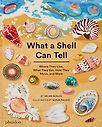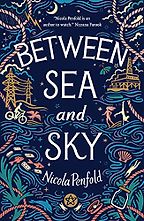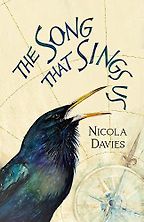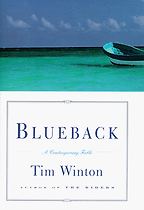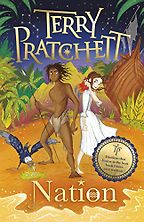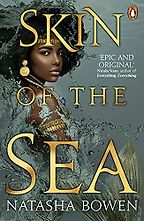When I asked you to recommend children’s books about the ocean I was expecting you to pick nonfiction, but you’ve gone for four novels and a novella. Before we start discussing the books themselves, can you tell me why you decided on fiction?
The reason I picked fiction was twofold. Since the pandemic, I’ve been drawn to reading stories more than I previously did. My writing continues to be nonfiction, but my reading has been increasingly immersed in the fictional world. I found that there is a great mix of stories that are being written, linked in different ways to the ocean. So I thought it would be good, maybe a little bit unusual, to consider the other kinds of ways in which books can connect readers to the ocean, especially readers who might not instinctively reach for the nonfiction books about the sea and sea creatures.
There are a lot of beautiful books out there that cover this part of our planet and our connections to it, and there are so many lovely books I could pick out from the nonfiction arena, like The Big Book of the Blue by Yuval Zommer, a stunning illustrated book for younger children. Ocean Anatomy by Julia Rothman is another lovely and perhaps more nerdy approach to the ocean and what lives there, how it all works, and why it’s important. Those books are fabulous.
I wanted to think about a slightly different way in which we can connect to the sea. There are so many stories to tell, through adventures and characters that in their own different ways have ideas and relationships with ocean spaces and with ocean species. What I would like to do with these book recommendations is to look at the power of stories to bring other readers into the ocean.
Do you want to talk a bit about what drew you to marine biology?
My own interest began in a quiet way. My family have always been nature-loving people. We spent a lot of time in the southwest of England, down in Cornwall. I was used to being outdoors and at the beach. For me, it was always normal to be there. Gradually, over time, I was drawn more and more to the ocean. I put my head under the water for the first time and saw it for myself snorkelling and then diving around the UK coast, by which point I was completely hooked on the idea of spending as much time as I could in the sea and exploring it. It was always about adventure and discovery and being there myself, and seeing these hidden wonders in the sea. That took me down the route of science and exploration, and then somewhat later as a writer too. It definitely began in my very young years, I don’t remember the first time I was on a beach. The sea has always been in my life.
The books that you have picked about the ocean are for children of various ages and engaging for adults too, but are mostly aimed at 10-14 year olds. Is this an age group that you particularly want to reach out to?
The 10-14 age range is an important one. I see it as a critical time for young readers. You have young kids who are very much drawn to nature and to animals and wildlife, be they dinosaurs or creepy crawlies in the garden. There are so many beautiful books that cater to those children. There are some like myself who will stick with it, who find themselves so captivated by nature that that will stay as part of their lives beyond those early years. And I think there are a lot of books for older readers that will naturally appeal to them. For instance, I see the popular science books I write as being very much for teens who have an interest in science and in the oceans.
“The 10-14 age range is an important one”
But there is an in-between age range where so much else is coming up in life that can take people away from those outdoor spaces and species. And I think there’s an important role in keeping those young readers who used to love being outside and finding bugs and that sort of thing, to maintain their interest and hopefully to keep them being in love with nature. Storytelling is a powerful way to do that. So I guess that’s a combination of why I chose fiction and also this particular age range. I think it’s an important time where—instead of letting nature fade away—you hopefully keep it in the minds of young people even when there’s so much else going on in their world.
I noticed that the authors and illustrator of your first two book picks are part of an organisation called Authors for Oceans.
Yes, I think there is a growing interest in putting nature—and oceans in particular—into storytelling, which is what this superb group is doing. The group is also about raising awareness of other ways books, authors and the publishing industry can take action to help the ocean. Many of them are the authors of amazing books that in different ways connect to the sea, and that was in my mind as I was thinking of these stories.
Let’s move on to your first book pick about the ocean for 10-14 year olds, Between Sea and Sky by Nicola Penfold, who is known for adventure novels about the natural world.
This book is a great ecological adventure. At its heart, it is a message of renewal and growth. It’s about the importance of friendship and holding on to hope no matter how bad things seem. The world she builds is quite muted and grey, but with flashes of colour and ideas that things can get better. It felt to me like a very realistic view of what the world could be like in the not too distant future, if we don’t take real action in the coming years against climate change as well as pollution and overfishing, the whole gamut of impacts that the ocean is facing from human activities. Between Sea and Sky is probably suitable for slightly younger children, 9-13 perhaps.
The author researched restorative ocean farming while writing this novel. I’m interested in what you think about that concept, and whether you’re as keen on seaweed as she is?
I’m very keen on seaweed. The idea of restorative farming is really interesting and exciting. There are some innovative projects looking at new ways of creating food and other products from the ocean. Farming the ocean in a thoughtful, creative way is not about simply putting in high-value fish species like salmon, but looking for different organisms that can genuinely create benefits for the ocean as well as providing food. Seaweed is a big part of that. It removes carbon from the atmosphere, it can be made into animal feed that reduces the methane they produce, and it’s good for people to eat too. Seaweed isn’t going to solve every problem we have in the ocean, and it’s not going to work everywhere.
These regenerative farms can incorporate other species, oysters, clams and so on, which can help clean the water and recycle nutrients within a three-dimensional farm that reaches from the surface down to the seabed. The concept also engenders a real sense of ownership of parts of the sea, which is something that’s often missing. People often think of the ocean as this big open space that no one owns. When it comes to ocean farming it can really be a case of a local ownership and stewardship. It’s great there are more people who want to produce food and make a living from the ocean in a way that’s going to create benefits and work for years to come rather than just stripping away ocean life and reaping the profits, which has happened so much before.
Let’s talk about your second ocean-related novel for 10-14 year olds, The Song that Sings Us. It’s by Nicola Davies, a zoologist, environmentalist and adventurer. She is also the narrator of the audio version.
Nicola Davies has written a lot of books for all sorts of ages. Having read this book and enjoyed it so much, I think anyone could read this or be read this story. It is incredibly rich and beautiful. It is a future-looking ecological dystopia, but I think there’s also a lot of utopia in there too. Nicola has an extraordinary way of creating a view of what a very different world could look like, and what characters within that world could be doing. It’s a very beautiful story, that’s the bottom line, and I love its subtlety. But it races along as well, it’s a fabulous adventure story.
Five Books interviews are expensive to produce. If you're enjoying this interview, please support us by donating a small amount.
It has an incredibly fast-paced, adrenaline-fuelled opening chapter.
It throws you into the story. She knows how to put her foot on the accelerator, and then also pull it off again and calm the pace. At those points it becomes deeply poetic and thoughtful. The depth of ecological thinking that went into this book is extraordinary. She is thinking about connections through the world, of what we can all do, the role of activism and resistance and how things can really be pushed towards change for the better. It’s a sweeping story, with glowing characters. If nothing else, read this for the magnificent elephant, or the tiger captain. Woven all through the story is this idea of the connections between humans and non-human animals. It’s the kind of book that makes you wish a lot of this could actually happen. I’d give anything to be able to understand the language of other animals and communicate with them. The Song that Sings Us speaks to why I chose fiction for this interview. What she does with her storytelling carries tremendous power to inspire readers and show them what’s possible.
Your next pick is Blueback, a novella which has won awards (including for the audio version), written by Tim Winton who has been named a living treasure by the National Trust of Australia. People talk about it as a crossover book for children and adults and it’s one that you also picked in a previous interview, so it has obviously stood the test of time for you.
This is the oldest title in my pick of five and it is one that’s been with me since it was published in 1997. Reading it for the first time, it perfectly captured how I feel when I’m in the ocean, when I’m exploring and diving and seeing things for myself. It’s about a boy called Abel Jackson who lives with his mother in an idyllic, wild part of Western Australia. Abel is always in the sea, and one day he meets and makes friends with a huge fish which he names Blueback. I found myself deeply wishing when I was a kid that I had made friends with a giant fish. I definitely share Abel’s desire to understand the ocean, to communicate with the animals that live there and learn their language but also to find out what it is that’s making the sea sick. This book unflinchingly looks at the encroachment of the modern world into the ocean. It is a story that absolutely—and very sadly—stands the test of time. Since it was written, very few of the problems, like overfishing and pollution, have got any better and most of them have got worse. Abel is also quite ahead of his time, an activist before kids were talking about activism. He instinctively knows he has to do something about the threats to his beloved bay. For all the troubles it shows, Blueback is an evocative and elegant portrayal of ocean life. That’s another reason why I love this book, it transports you under the waves in such a vivid way.
Your next pick of ocean-related novels for 10-14 year olds is Nation by Terry Pratchett. It is a prize-winning alternate history set in the 1860s with fantasy elements, and was a Michael L. Printz honor book in 2009.
Terry Pratchett is a master world builder. This is a standalone book, not part of his Discworld series, and it’s an absolute joy to read. I’m a big fan of all Pratchett, and for me Nation stands out because it is so oceanic in its topic, in its breadth and in its storytelling. It’s an alternative history set in the Great Southern Pelagic Ocean. It’s a book about cultures coming together and learning from each other. It’s about environmental disasters, and how people adapt and cope with them. It’s incredibly rich with details of the world that we’re exploring, a realistic but slightly different version of our world. The characters are glorious, and it’s a brilliantly funny book but deeply thoughtful as well, which is what you always get from Pratchett. I love that he brought his view of the world to the ocean in such a gorgeous way in this book, it really is a lot of fun. This novel would probably work best for children age 12 and up.
Your final pick is Skin of the Sea by Natasha Bowen, which looks like a fabulous retelling of Hans Christian Andersen’s 1837 tale of love, sacrifice and eternal soul, The Little Mermaid.
Skin of the Sea ties into all sorts of mythologies, primarily the West African mythology of Mami Wata. This character is a legendary, powerful mermaid who appears in different incarnations and stories across the African diaspora. She’s a fascinating mix of different cultural influences, including European mermaid myths. Natasha Bowen brings Mami Wata into the very real and very dark stories of the people who lost their lives while they were being shipped into slavery in the Americas, and whose bodies were thrown into the Atlantic Ocean. Her book makes an important contribution to a growing body of work, including literature, visual art and music, that’s keeping alive the cultural connections to the deep seabed and the Atlantic Middle Passage, which is the final, hidden resting place for millions of people. I see this book as part of a virtual memorial that’s helping to keep these stories in people’s minds and not let them be forgotten. That’s what originally drew me to the book, and then reading it I loved being whisked away to this mythical version of the ocean. There are many living and real wonders in the ocean, but it’s always exciting to explore other possibilities of what could be going on there. There’s so much you can’t see in the ocean and people have always filled it with imaginary gods and monsters. Perhaps there really could be mermaids, we just haven’t quite found them yet. They’ve been swimming through people’s minds for so long, and I love that they continue to do so today. I think it’s wonderful that we have modern interpretations of age-old characters, and they still have tremendous relevance today.
Your book picks about the ocean are focused on the 10-14 age range, but this novel seems aimed at slightly older readers?
Yes, it is a fairy tale for teens. It’s a love story. And there is a darkness to this one, certainly, with the connection to the slave trade and what happened to so many people. This one is probably most suitable for 13-17 year olds.
Can I ask you something personal? Do you eat seafood?
I gave up eating meat when I was a teenager, outraged about the Amazon rainforest being cut down to make way for cattle ranches. I kept on eating seafood for years but now I eat very little, and only if I can be sure it’s been sustainably and ethically caught. If I’m totally honest, the only reason I haven’t quite given up seafood entirely is because I can’t resist how delicious it is!
Has sustainable fishing been properly defined? Should we feel confident when we eat seafood that claims to be sustainable?
It’s complicated. You can imagine that as a marine biologist who is outspoken about these issues, I’m an absolute bore at dinner parties. I will ask “What species is that? Where was it caught? And how was it caught?” Ultimately, you need to know all that to be sure about sustainability, but it can be a real minefield. Just saying North Sea cod, for instance, isn’t enough. You can get good advice from things like the Good Fish Guide, which is a website and a smartphone app, and breaks things down in terms of better and worse options. There is a similar one put out by Monterey Bay Aquarium called Seafood Watch which is for species generally available in North America. The Australian Marine Conservation Society has an equivalent called GoodFish. Some of the eco-labelling systems like the Marine Stewardship Council can show which are the better options, but they do have issues. Ultimately, if you eat seafood then it’s up to you to try and be thoughtful and find out more about what you eat and where it comes from.
Do we understand as much about the relationship between the ocean and climate change as we do about the effects of human impacts on land habitats such as rainforest and peatland?
The oceans are critically important for climate change. For starters, they have absorbed around 90 per cent of the excess heat trapped in the atmosphere by greenhouse gases. If it wasn’t for all that water, covering seven-tenths of the earth, we’d be in an even more catastrophic situation than we are now. A huge amount of carbon also gets sequestered in the ocean, sinking into the deep and locked up in habitats like kelp forests, seagrass meadows, salt marshes and mangrove forests. And just like forests and peatlands on land, those habitats are being damaged and destroyed at terrifying rates. For example, the UK has lost 44% of its seagrasses since the 1930s. People are now working hard to replant seagrasses and bring back this carbon-supping ecosystem. It will also be good news for all the species that live in seagrass. The more seagrass meadows there are, the more habitat there will be for amazing species like seahorses.
Sign up here for our newsletter featuring the best children’s
and young adult books, as recommended by authors, teachers, librarians and,
of course, kids.
At the same time that we’re understanding more about how the ocean plays a key role in mitigating climate change, human impacts in the ocean are also making the climate crisis worse. Fishing has various impacts on the climate. The fishing industry has an enormous fuel bill because of the types of vessels used to go and catch fish. In particular fishing in distant waters—and especially in deeper waters—is so fuel-intensive that most of those fisheries wouldn’t be economically viable if they weren’t getting fuel subsidies from governments. So, it doesn’t make any economic sense, let alone any environmental sense, to fish in those areas. And high seas fisheries aren’t feeding the world. Mostly they’re providing fish that goes to high-income nations. To make matters worse, a lot of the fish being targeted play a big role in the carbon cycle. They help draw carbon into the deep ocean, keeping it away from the atmosphere. So, people are disrupting those critical pathways, too, by overfishing.
Having young people read books about the ocean and wanting to be marine biologists would be an excellent way forward.
Absolutely, I’ve noticed a growing excitement lately surrounding the ocean. A lot of kids I meet tell me they want to be a marine biologist, which is fabulous. We need as many brilliant people as possible working in the ocean. But an important message I also want to get across is that you don’t have to be a marine biologist—the oceans are for everyone. They matter for us all. Spending time by, on and in the sea can benefit you whatever you do in life. So whether or not you feel like science or conservation is for you, the oceans are definitely for you. And the oceans need you. I want as many people as possible to know and care about what lives there, what the problems are and to fight for a better future for the oceans.
I love stories about the sea because they bring many more people into the ocean realm. This is not an exclusive space for people who can scuba dive and who want to be under the water as much as above it. The ocean really is for everyone and stories like these show that there are many different ways to connect to the sea.
Interview by Tuva Kahrs
June 8, 2022. Updated: September 27, 2023
Five Books aims to keep its book recommendations and interviews up to date. If you are the interviewee and would like to update your choice of books (or even just what you say about them) please email us at [email protected]

